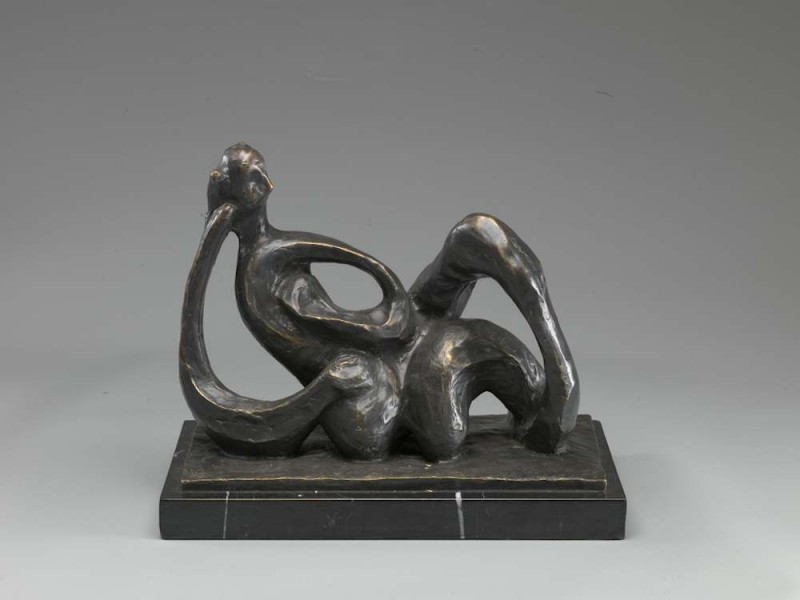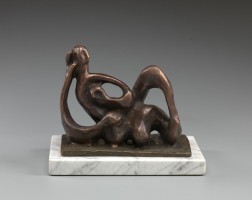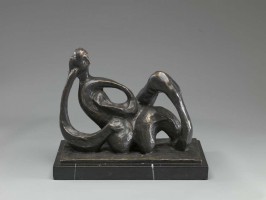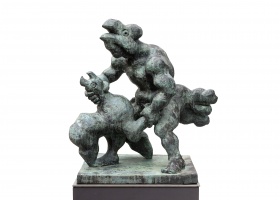


Hagara II
| Author: |
Jacques Lipchitz (1891–1973)  |
| Created: | ca 1950 |
| Material: | bronze |
| Dimensions: | 23 × 28.80 cm |
| Signature: | on the pedestal: JLipchitz |
This sculpture is part of a series based on the Old Testament figure of Hagar, the Egyptian maidservant who bore Abraham’s son Ishmael. When Sarah, who had been barren for many years, finally gave birth to her own child, Isaac, she and Abraham sent Hagar and Ishmael into the wilderness. Lost and despairing, exhausted and thirsty, Hagar heard the voice of an angel, and found a well that saved her. This tale of betrayal, protection and displacement has an immense significance in the origins of Judaism. For Jacques Lipchitz (1891–1973), a Jewish sculptor who was himself forced to flee from Europe and found refuge in America, where he married for the second time, the story of Hagar probably resonated deeply. The timing of his exploration of the theme is significant: he began to work on this subject in 1948 during the Arab-Israeli war. In his autobiography, he describes the theme of Hagar as ‘a prayer for Jewish-Arab brotherhood’. Throughout the late 1940s, he explored the theme of Hagar across various media, including plaster, bronze and drawing. Each piece in the series conveys a sense of tragedy mingled with hope.
Text author Jurgita Ludavičienė
The woman, kosher and emancipation. The first woman, and Adam’s first wife, was Lilith, whom God created from Adam’s rib (in the Christian translation she is simply called the Woman, Genesis 2, 21–23). Lilith considered herself equal to man, but Adam did not agree with this, and Lilith left the Garden of Eden. God sent three angels to bring her back, but she refused to return until her husband recognised her as an equal. God then created Eve, an obedient wife for Adam, and Lilith was punished. She became a winged demon with long hair, terrorising women in labour and newborn babies, seducing and preying on men in their erotic dreams.
Since Ancient times, all religious Jews have followed kosher rules (in Yiddish kosher, in Hebrew kasher, kashrut, ‘proper, correct’) that cover all areas of life and regulate the performance of rituals, diet, clothing, hygiene and other daily requirements. One of the biggest sins is nudity, so women must wear modest clothes and shoes, and married women must hide their hair under hats or wigs, because they must not tempt other men. For centuries, Lilith was the epitome of the ‘non-kosher’ wife, but today she has become a symbol of women’s emancipation and equality. This is how Lilith was depicted by Nikol Schattenstein, Emmanuel Mané-Katz, Jacques Lipchitz and Samuel Tepler. Images of female nudes challenge the traditional view of women, and symbolise the opposition of the artists to the dogmas of Judaism.
Text author Vilma Gradinskaitė
Source: Law firm Valiunas Ellex art album MORE THAN JUST BEAUTY (2012). Compiler and author Giedrė Jankevičiūtė, STORIES OF LITVAK ART (2023). Compiler and author Vilma Gradinskaitė, THE ART OF MATERIALS. Compiler and text author Jurgita LudavičienėExpositions: “More Than Just Beauty: The Image of Woman in the LAWIN collection”, 12 October – 11 November 2012, National Gallery of Art, Vilnius; “Life in Sculpture. Jacques Lipchitz – 125”, 1 July –25 September 2016, The Tolerance Centre of the Vilna Gaon State Jewish Museum, Vilnius; "Free and Unfree. Lithuanian Art between 1945 and 1990", 9 September 2021 – 30 April 2022, Lithuanian Art Centre TARTLE (Užupio St. 40, Vilnius). Curators Dovilė Barcytė and Ieva Burbaitė.










_web.jpg)